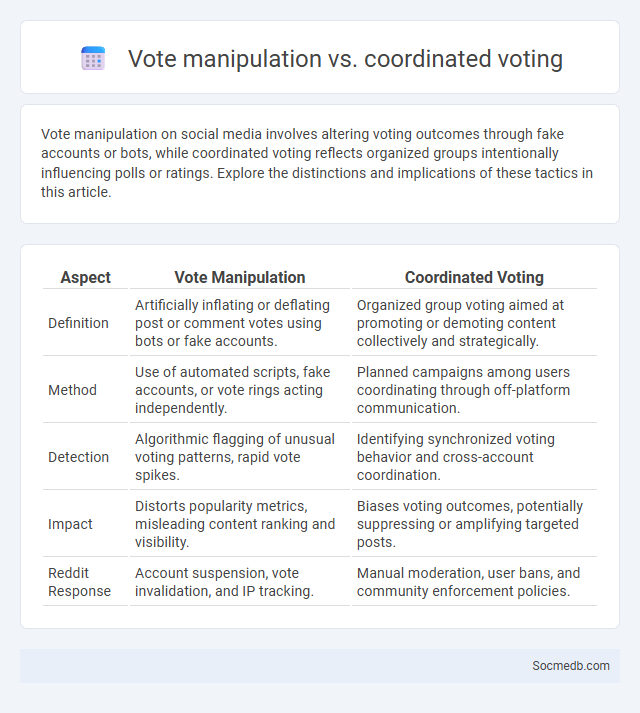
Photo illustration: vote manipulation vs coordinated voting
Vote manipulation on social media involves altering voting outcomes through fake accounts or bots, while coordinated voting reflects organized groups intentionally influencing polls or ratings. Explore the distinctions and implications of these tactics in this article.
Table of Comparison
| Aspect | Vote Manipulation | Coordinated Voting |
|---|---|---|
| Definition | Artificially inflating or deflating post or comment votes using bots or fake accounts. | Organized group voting aimed at promoting or demoting content collectively and strategically. |
| Method | Use of automated scripts, fake accounts, or vote rings acting independently. | Planned campaigns among users coordinating through off-platform communication. |
| Detection | Algorithmic flagging of unusual voting patterns, rapid vote spikes. | Identifying synchronized voting behavior and cross-account coordination. |
| Impact | Distorts popularity metrics, misleading content ranking and visibility. | Biases voting outcomes, potentially suppressing or amplifying targeted posts. |
| Reddit Response | Account suspension, vote invalidation, and IP tracking. | Manual moderation, user bans, and community enforcement policies. |
Understanding Vote Manipulation
Vote manipulation on social media involves tactics such as fake accounts, bots, and coordinated campaigns designed to alter voting outcomes or engagement metrics. These deceptive practices undermine platform integrity by skewing popularity, credibility, and user trust in polls or content ranking. Detecting vote manipulation requires advanced algorithms analyzing user behavior patterns, IP addresses, and interaction anomalies to maintain authentic social media environments.
Defining Coordinated Voting
Coordinated voting on social media refers to the organized effort by groups of users to manipulate poll outcomes or trending topics through synchronized voting or engagement. This tactic often involves automated bots or campaigns that amplify specific opinions to skew public perception and influence decision-making processes. Detecting coordinated voting requires analyzing patterns of activity, timing, and user behavior to identify artificial inflation of support.
Key Differences: Vote Manipulation vs Coordinated Voting
Vote manipulation involves deceptive techniques where individuals artificially inflate or deflate votes on social media posts, often using bots or fake accounts to distort genuine user engagement. Coordinated voting, however, refers to organized groups strategically mobilizing real users to collectively vote in alignment with specific goals or campaigns, amplifying targeted content organically. Understanding these key differences helps you identify authentic social media interactions and protect the integrity of online communities.
Common Tactics in Vote Manipulation
Common tactics in vote manipulation on social media include deploying coordinated bot networks to artificially inflate the popularity of specific options and using fake accounts to cast multiple votes, skewing results. Targeted misinformation campaigns and hashtag spamming can influence public perception and direct voting behavior. Exploiting algorithmic biases by mass reporting or promoting content helps manipulators dominate trending topics and mislead genuine participants.
How Coordinated Voting Influences Outcomes
Coordinated voting substantially impacts election results by amplifying collective preferences through synchronized voting strategies and targeted campaigns on social media platforms like Twitter and Facebook. Algorithms prioritize trending hashtags and shared content, enabling rapid mobilization of voters with similar political views, thereby swaying public opinion and poll outcomes. Data analytics and sentiment analysis further refine these efforts, ensuring message precision and maximizing voter turnout within key demographics.
Legal and Ethical Implications
Social media platforms raise significant legal and ethical implications, including privacy concerns, data protection regulations like GDPR, and the dissemination of misinformation. You must navigate responsibilities related to content ownership, intellectual property rights, and potential defamation claims. Ensuring ethical use involves maintaining transparency, respecting user consent, and preventing harmful or discriminatory behavior online.
Detection Methods for Manipulative Voting
Detection methods for manipulative voting on social media platforms utilize machine learning algorithms and network analysis to identify suspicious voting patterns and coordinated inauthentic behavior. Advanced techniques include anomaly detection, sentiment analysis, and bot activity monitoring, which help pinpoint artificial vote amplification or vote suppression attempts. Leveraging real-time data analytics and user behavior modeling improves the accuracy of identifying manipulation and enhances platform integrity.
Real-World Examples of Vote Manipulation
Social media platforms like Twitter and Facebook have experienced significant vote manipulation, with coordinated campaigns artificially inflating likes, shares, and poll results, often driven by bots or fake accounts. During the 2016 US presidential election, researchers identified thousands of automated accounts amplifying misinformation and skewing public opinion through manipulated votes and engagement metrics. Your online decisions can be influenced by these tactics, highlighting the importance of critically evaluating social media content and recognizing potential manipulation efforts.
Safeguards Against Coordinated Voting
Social media platforms deploy advanced algorithms and machine learning techniques to detect patterns of coordinated voting, such as synchronized likes, shares, or upvotes intended to manipulate content visibility. These safeguards include monitoring IP addresses, analyzing account behavior for sudden spikes in activity, and cross-referencing user interactions to identify member clusters acting in unison. Implementing rate limits, captcha challenges, and user verification further strengthens defenses against artificial inflation of engagement metrics.
Ensuring Integrity in Modern Voting Systems
Social media platforms play a critical role in ensuring integrity in modern voting systems by enabling rapid dissemination of accurate information and countering misinformation. You can actively contribute to safeguarding democratic processes by verifying sources and reporting false content that undermines election transparency. Leveraging social media for voter education and engagement enhances trust and accountability across contemporary electoral frameworks.
 socmedb.com
socmedb.com